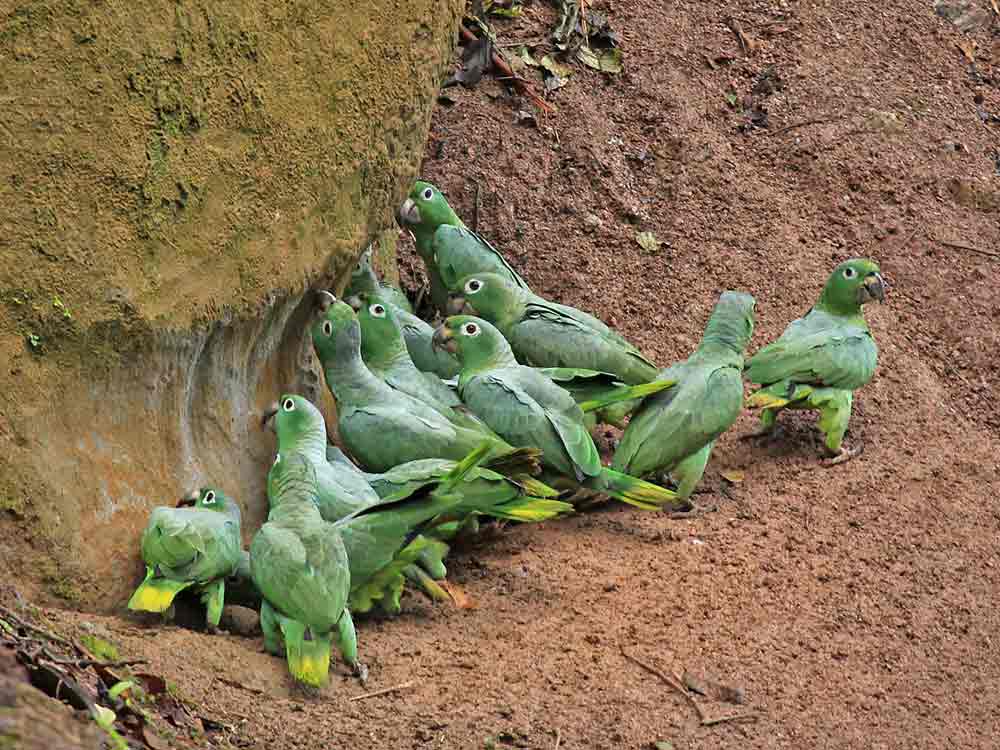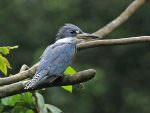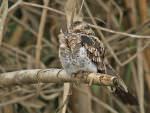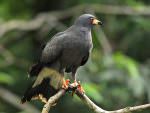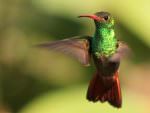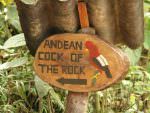Itinerary and price
Day 1: Flight to Quito to be organised by you.
For help with your flight arrangements and to receive a no obligation quote, you can complete the enquiry form on our website or call 0800 280 8947 to speak to a flight advisor at StudentUniverse (in partnership with Gapyear.com), part of the Flight Centre Travel Group, a leading retailer of airfares and worldwide flights.
Meals: Payable directly today
Some flights departing the UK early in the morning arrive in Quito late afternoon/evening.
Your driver will be outside Quito airport (look for your name on a placard) to welcome you and transfer you to Hotel Sebastian or similar. Relax for the remainder of the day.
Note: Quito is located at high altitude in the Andes, almost 3,000 metres. To avoid any symptoms of altitude sickness and prepare for the following day we advise as early a night as possible with plenty of sleep AND avoid alcohol until you reach lower altitudes.
Day 2: Quito – Bellavista (Upper Tandayapa Valley)
Meals: Breakfast in Quito, lunch and dinner at Bellavista
After breakfast our experienced guide will arrive at your hotel at 0730 hours and you'll be driven (approx. 2 hours) to Bellavista, nestled in the cloud forest at the top end of the Tandayapa Valley, where you will be based for six nights. You'll be able to enjoy birding along Bellavista trails in different areas of the reserve today and some very productive road-side birding during the course of your stay. Some of the speciality species here include Beautiful Jay, Golden-headed and Crested Quetzal, Tanager Finch and Swallow-tailed Nightjar. Sickle-winged Guan, Grass-green and Flame-throated Tanagers, Purple-bibbed Whitetip and Red-billed Parrot are all likely. All guided birding is on a shared guide basis. Relax for the evening. The recently discovered Olinguito (an arboreal mammal) sometimes comes to a feeding station at the lodge, so fingers crossed for a sighting.
Days 3, 4, 5, 6 and 7: Bellavista area with visits to Angel Paz Reserve, Milpe, Rio Silanche, Alambi and other sites with extra time spent around Bellavista itself
Please note: One of these nights may be spent in the region of Pedro Vicente Maldonado for better access to local reserves.
Meals: Breakfast, lunch (or box lunch) and dinner at Bellavista
Over the course of these days you’ll visit the above sites. The order and the number of times you visit may vary, depending on the other clients staying at Bellavista at the time. Guiding will be on a shared basis. You are sure to agree that visiting any of these places more than once will be well worthwhile, and chances are you’ll see some different species on each visit. Birding in lush lichen-draped cloud forest habitats can be tough, but exceptionally rewarding.
Sites to be visited include:
Bellavista trails and local environs (c. 2,300m)
There is so much to see around Bellavista and today you’ll explore locally in a small group with your guide during two organised walks. Some of the special species might include Swallow-tailed Nightjar, Beautiful Jay, Tanager Finch, Golden-headed and Crested Quetzals. You could see Sickle-winged Guan, Grass-green Tanager, Purple-bibbed Whitetip, Gorgeted Sunangel and Red-billed Parrot. You can often see 10 species of hummingbird visiting the feeders at once and up to 20 species or so within one hour including the characterful Booted Racket-tail. In between walks and excursions you can relax or explore locally on your own too. Nights at Bellavista Lodge in the cloud forest. You’ll have plenty of opportunity to explore around Bellavista itself.
Angel Paz Reserve
Early one morning you’ll enjoy an unforgettable experience, a visit to Angel Paz’s private forest reserve, well known for the owner offering juicy worms to entice onto the forest trails some sought-after species that are usually difficult to see - Giant, Yellow-breasted, Ochre-breasted and Moustached Antpittas. It isn’t just the antpittas, though, as this diverse forest is home to many brightly coloured species, including Andean Cock-of-the-rock, Orange-breasted Fruiteater and the more cryptically-coloured Dark-backed Wood-Quail. With a little luck this morning could yield Golden-winged Manakin, Golden-headed Quetzal and Rufous-bellied Nighthawk, Pauraque and perhaps Chestnut-crowned Antpitta!
Milpe
If you ever watched the Life of Birds, you may have seen David Attenborough captivated by the sight of displaying Manakins. Today you will explore the fascinating forest trails at Milpe, run by the Mindo Cloudforest Foundation (MCF) and hopefully you, too, will be captivated by Club-winged Manakin. Obviously you can never guarantee wildlife, but fingers crossed you'll see them and perhaps Choco Toucan and Choco Trogon as well as some of the other endemic birds of the Choco region which occur here. Other targets include Glistening-green, Moss-backed and Rufous-throated Tanagers, Esmeraldas Antbird and Pacific Tuftedcheek. Lunch will be provided locally and you may visit San Miguel’s Restaurant in Los Bancos, complete with a bird feeding station by the window and lovely views from high above the Rio Blanco.
Rio Silanche
Rio Silanche, also run by MCF, has an extensive bird list. Here your guide will help you search for Pacific Parrotlet and Pacific Hornero (both are Tumbesian endemics), Orange-fronted Barbet, Scarlet-breasted Dacnis, Grey-and-gold, Blue-whiskered, Ochre-breasted and Scarlet-browed Tanagers (all Choco endemics) and many other species that are easier to see like White-bearded Manakin, Squirrel Cuckoo, Rufous-tailed and Purple-chested Hummingbirds, Golden-olive Woodpecker, Masked Tityra, Yellow-tufted Dacnis and more tanagers including Silver-throated, Blue-necked and Golden-hooded. As well as forest trails to explore for White-bearded Manakin, there is a 15m high observation platform where, depending on luck, Swallow-tailed Kites sometimes grace the skies.
Alambi Hummingbird and Tanager Reserve
32 different species of hummingbird have been recorded from the feeders or in the Reserve at this wonderful site and often you can expect 12 – 15 species on a visit, depending on the seasons, not to mention Maroon-chested Ground-doves recorded in the lodge garden and Lyre-tailed Nightjar in the parking area! On a typical visit around the feeders and garden plants look out for Western Emerald, White-necked Jacobin, Purple-throated Woodstar, Booted Racket-tail and Green-crowned Woodnymph. Red-headed Barbet, Ecuadorian Thrush, Choco Brush Finch and Yellow-tufted Dacnis are all attracted to the fruit which is put out and the natural food available in the forest, while a walk down to the river can result in views of White-capped Dipper, Golden-headed Quetzals and Pacific Hornero and many other birds, frogs, butterflies and flowers.
Day 8: Bellavista – Quito
Meals: Breakfast and lunch
After further birding today around Bellavista and the Mindo area your driver till take you back to Quito to arrive early/mid evening.
You’ll be dropped at hotel Casa Aliso in Quito where you’ll say farewell to your driver and take time to reflect on the amazing experiences of the past week. Dinner tonight is payable directly and there are a few local restaurants to choose from close to Casa Aliso. Reception staff will give you directions.
Day 9: Quito – Coca – Sacha Lodge, Amazonia
Meals: Breakfast in Quito, packed lunch in Coca and dinner at Sacha
A short flight of 30 minutes takes you to Puerto Francisco de Orellana, locally known as Coca. A warm welcome will await you at the airport and you’ll be taken for lunch before boarding a large motorised canoe. From here it’s a journey of approximately two hours along the Rio Napo - look out for Great Yellow-headed Vulture overhead and Oriole Blackbird, Giant Cowbird and Pied Plovers on the river islands as you go. A short stroll along a boardwalk, then the final leg of the journey by dugout canoe and Sacha Lodge will come into view on the edge of Pilchicocha Lake.
By now you may well have seen the very vocal Red Howler Monkeys as well as Black-fronted Nunbirds, Hoatzins and Great or Common Potoo!
On reaching Sacha Lodge you will be split into groups of up to six and the programme for the next few days will be explained. The remaining time this afternoon can be spent relaxing in your hammock or scanning from the jetty overlooking Lake Pilchicocha, where Black Caiman feed and very occasionally Giant River Otters are seen.
The wildlife around Sacha is extremely diverse and your guides will identify and point out the many characteristic species of the area such as Many-banded Aracari, Spangled Cotinga, Blue and Yellow Macaw, Golden-collared Toucanet, Opal-rumped and Green and Gold Tanagers.
Your nights will be in a comfortable cabin with western style bathroom and shower.
Please note: If you visit the Parrot clay licks whilst based at Sacha Lodge you will need to pay the Yasuni National Park entrance fee of around $22 per person directly. However, from Napo Wildlife Centre the entrance fee is included in the price, so feel free to mention to Sacha staff you’d prefer to stay with a group to explore the Sacha trails as you will visit the clay licks from Napo as detailed below. You can, of course, visit the parrot clay licks twice, from both locations, if you wish.
Days 10 and 11: Sacha
Meals: Breakfast, lunch and dinner
The programme for these days will include a morning and a late afternoon/early evening excursion which will include:
Treetop viewing from a sturdy canopy walkway with observation platforms at each end and in the middle. The sound of tropical birds, mixed with cicadas and frogs can be almost (pleasantly) deafening at times – just one of the many experiences you’ll remember from your holiday. In the canopy you should see White-throated Toucan, Russet-backed Oropendola, Purple-throated and Spangled Cotingas, Ivory-billed Aracari, Yellow-tufted Woodpecker and many other species.
Canopy viewing from a 40+ metre high observation tower. Breathtaking views across the rain forest canopy for as far as the eye can see, and long may it last! Canopy birding continues with so many species on offer that might include various birds of prey overhead such as Black Caracara, Crane Hawk and Slender-billed Kite, with White-lored Euphonia, Green-and-Gold Tanager, Purple-throated Fruitcrow and if you are lucky Tawny-bellied Screech Owl seen from a nearby trail.
Creek exploration by dugout canoe, and it isn’t all about birds – you might see Black or Spectacled Caiman, Caiman Lizard, maybe an Anaconda and hopefully some very beautiful tropical butterflies, including the large and very bright Blue Morpho. Many birds will put in an appearance – Black-capped Donacobius, Limpkin, Black-crowned Night Heron, Greater Ani, Snail Kite and you may see the wonderful Hoatzins again.
Guided walks along forest trails where you may see Kinkajous, skulking antbirds such as White-shouldered, Spot-backed, Silvered and Black-faced. With a little luck you may see stunning Wire-tailed and White-bearded Manakins and perhaps even Crested Owls if the guides know of a roost site. And if you are very, very lucky, a Southern Tamandua (anteater).
The order of the activities and number of times you do them will vary. Usually in the middle of the day you’ll find some time to relax or explore the area around the lodge itself on your own.
Nights at Sacha Lodge
Day 12: Sacha – Napo
Meals: Breakfast at Sacha, lunch and dinner at Napo
You’ll leave Sacha lodge after breakfast (speak to your guide the day before and he will confirm the time). You’ll be taken back along the creek, then onto the boardwalk and arrive back at the edge of the Rio Napo where your Napo Wildlife Centre guide will be waiting for you in a motorised canoe to take you the short distance across the water, where your adventure in Yasuni National Park (and UNESCO Biosphere Reserve of approx. 82 square miles) begins!
From the welcome point, the journey to Napo Wildlife Centre (your lodge) is by dugout canoe, along channels and across the lake. Throughout the journey your guide will be watching for Anaconda, Red and Green Macaw, and if you are lucky perhaps an elusive Zigzag Heron or occasionally Giant Otter is seen too. Eventually you’ll arrive at Napo Wildlife Centre, nestled on the side of a lake with a forested backdrop. You’ll be shown to your comfortable accommodation in an idyllic setting and all will be explained to make the most of your stay.
Days 13, 14 and 15: Napo (Yasuni National Park)
Meals: Breakfast, lunch and dinner
You’ll explore trails on foot and channels by dugout canoe. There are two canopy towers to visit during your stay at Napo Wildlife Centre were you might see Green-and-Gold Tanager, Gilded Barbet, Purple-throated Fruitcrow, Channel-billed Toucan, Blue Dacnis, Paradise Tanager and even the monkey-eating Harpy Eagle or Crested Eagle if you are very lucky.
On one of the days you will visit at least one of Yasuni National Park’s clay licks. With a bit of luck hundreds of Cobalt-winged Parakeets, Mealy Amazons and sometimes Orange-cheeked Parrots will visit for their essential mineral intake. Occasionally the larger Macaws can visit, including Scarlet Macaw. The number of species and number of individual birds varies depending on weather, time of year and, of course, that little bit of luck. The Yasuni National Park entrance fee is included during your stay at Napo Wildlife Centre, so you won't need to pay it to visit the clay licks.
A couple of other species of monkey can be seen here too, Golden Mantled Tamarin (featured on the Napo Wildlife Centre logo), Dusky Titi Monkey and even Equatorial Saki Monkey. Hopefully they will give a slide show about what mammals they have recorded during monitoring with camera traps. You’ll be absolutely amazed at the diversity, though many of these species are highly nocturnal and difficult to see.
It’s hard to explain the experience of exploring by dugout canoe – you really need to be there to fully appreciate just how astoundingly wonderful it is! Will there be an Anaconda round the next corner, a Sungrebe or a Cocoi or Rufescent Tiger Heron? You’ll see plenty more Hoatzins and perhaps higher up in the canopy Spix’s and Blue-throated Piping Guans. The guides know where to look for species like Greater Potoo, White-chinned Jacamar and many others..
Nights at Napo Wildlife Centre.
Day 16: Napo – Coca – Quito
Meals: Breakfast
Today your journey back to Coca and Quito begins quite early (at a time to be confirmed which will link with your internal flights from Coca to Quito – details of flights to be advised). All the transfers from the Port to the airport are included in the price.
Tour ends at the airport.
Note: You can if you wish extend your experience in the Amazon rain forest with extra days at Sacha Lodge or Napo Wildlife Centre. Please enquire and we can supply a supplement.
Extra note: If you require an extra night in Quito to link with your international flight the next morning please enquire and we can confirm what the extra cost will be.
Approx. price per person valid to 31 December 2019:
Based on two travelling on a twin share basis: US $4360
Based on three travelling on a twin share basis: US $4295
Based on four travelling on a twin share basis: US $4185
Single supplement US $1360
Price includes:
Accommodation as specified
All land transfers
Meals as mentioned above
All entrance fees to sanctuaries for the whole tour (except Yasuni in the Amazon if you visit the parrot clay licks from Sacha Lodge which is payable directly – approx. $22)
Bird checklist, pre-travel and top tips for travel advice
Services of an experienced guide
on a shared basis for the West slope
And for the Amazon…
All land/boat transfers
Experienced bilingual naturalist guide at Sacha Lodge and a native guide
on a shared basis (max. group size is usually 6 at Sacha)
Experienced bilingual naturalist guide at Napo Wildlife Centre and a native guide
on a shared basis (max. group size is up to 8 at Napo)
Price excludes:
International flight
Internal flight from Quito – Coca and Coca – Quito (approx. US $220 per person)
Yasuni entrance fee if you visit the parrot clay lick from Sacha Lodge (approx. US $22 per person)
Travel insurance
All drinks. You may need to purchase teas/coffees/beer every now and again at establishments with excellent veranda/restaurant bird feeding stations. Filtered water in the Amazon is usually available, but bottled water would need to be purchased
Tips
Phone calls, laundry and anything else of personal nature



